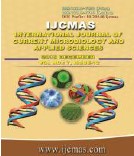


 National Academy of Agricultural Sciences (NAAS)
National Academy of Agricultural Sciences (NAAS)

|
PRINT ISSN : 2319-7692
Online ISSN : 2319-7706 Issues : 12 per year Publisher : Excellent Publishers Email : editorijcmas@gmail.com / submit@ijcmas.com Editor-in-chief: Dr.M.Prakash Index Copernicus ICV 2018: 95.39 NAAS RATING 2020: 5.38 |
Traditional farming has imbalance and excess use of chemicals and, in turn, to negative environmental impacts on soil health, groundwater, and atmosphere. Sensor based farming system should be more sustainable to reach economical and social profitability as well as the sustainable environment. A correct solution is to adopt precision farming, the best option for sustaining food production without declining the ecosystem. Precision technologies are used for integrating information about spatial and temporal differences within the field in order to match inputs to site-specific field conditions. The aims are to perform an investigation both on approaches and results of site-specific N management in wheat crop and to analyse performance and sustainability of agricultural practice. The earlier creation N management decisions, both the measurement and understanding of soil spatial variability and the wheat N status are needed. Complementary use of different sensors has improved soil quality relatively low cost. The red edge and near-infrared bands can penetrate into higher vegetation fraction of the canopy. These narrow bands better estimated grain yield, crop N and water status, with R2 higher than 0.70. The various diagnostic tools and procedures have been developed in order to help wheat growing farmers for planning variable N rates. The field studies in which sensor-based N management system was compared with common farmer practices showed high increases in the N use efficiency of up to 368 per cent. These systems saved N fertilizers, vary from 10 per cent to about 80 per cent less N, and reduced residual N in the soil by 30-50 per cent, without deteriorating yields or grain quality; the sensor based N management on real-time sensing and fertilization had the highest profitability compared to fixed time and undifferentiated applications. Fixed time N management though fetched good economic return but incurred higher fertilizer N consumption than required to produce the expected yield. Moderate rate of N topdressing at medium SPAD was found best for precision N management in wheat crop aiming at greater profit with higher N use efficiency. Their study suggests that SPAD meter based N management saved about 30 per cent of the existing N fertilizer recommendation in FTNM. Maintaining SPAD threshold value of 42 with topdressing 20 kg N ha-1 at each time had a significant positive effect on grain yield with a saving of N fertilizer as compared to FTNM.
 |
 |
 |
 |
 |